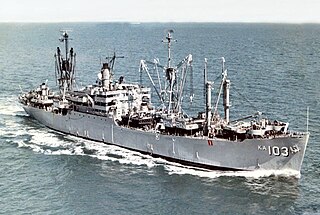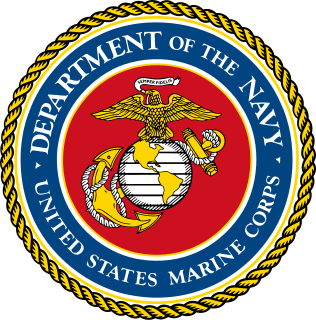Related Research Articles

The United States Pacific Fleet (USPACFLT) is a theater-level component command of the United States Navy, located in the Pacific Ocean. It provides naval forces to the Indo-Pacific Command. Fleet headquarters is at Joint Base Pearl Harbor–Hickam, Hawaii, with large secondary facilities at Naval Air Station North Island, California.

The United States Fleet Forces Command (USFF) is a service component command of the United States Navy that provides naval forces to a wide variety of U.S. forces. The naval resources may be allocated to Combatant Commanders such as United States Northern Command (USNORTHCOM) under the authority of the Secretary of Defense. Originally formed as United States Atlantic Fleet (USLANTFLT) in 1906, it has been an integral part of the defense of the United States of America since the early 20th century. In 2002, the Fleet comprised over 118,000 Navy and Marine Corps personnel serving on 186 ships and in 1,300 aircraft, with an area of responsibility ranging over most of the Atlantic Ocean from the North Pole to the South Pole, the Caribbean Sea, Gulf of Mexico, and the waters of the Pacific Ocean along the coasts of Central and South America.

The Seventh Fleet is a numbered fleet of the United States Navy. It is headquartered at U.S. Fleet Activities Yokosuka, in Yokosuka, Kanagawa Prefecture, Japan. It is part of the United States Pacific Fleet. At present, it is the largest of the forward-deployed U.S. fleets, with 50 to 70 ships, 150 aircraft and 27,000 Sailors and Marines. Its principal responsibilities are to provide joint command in natural disaster or military operations and operational command of all US naval forces in the region.

The Fifth Fleet is a numbered fleet of the United States Navy. It has been responsible for naval forces in the Persian Gulf, Red Sea, Arabian Sea, and parts of the Indian Ocean since 1995 after a 48-year hiatus. It shares a commander and headquarters with U.S. Naval Forces Central Command (NAVCENT) in Bahrain. Fifth Fleet/NAVCENT is a component command of, and reports to, U.S. Central Command (CENTCOM).

Admiral Richmond Kelly Turner, commonly known as Admiral Kelly Turner, served in the United States Navy during World War II, and is best known for commanding the Amphibious Force during the campaign across the Pacific. Admiral Turner was responsible for the creation of the Underwater Demolition Teams (UDT) that were an early precursor to the United States Navy Seals.

The South Pacific Area (SOPAC) was a multinational U.S.-led military command active during World War II. It was a part of the U.S. Pacific Ocean Areas under Admiral Chester Nimitz.

Vice Admiral Daniel Edward Barbey was an officer in the United States Navy who served in World War I and World War II. A graduate of the Naval Academy, he participated in the 1912 United States occupation of Nicaragua and the 1915 United States occupation of Veracruz. While serving with the War Plans Section of the Bureau of Navigation in Washington, D.C. between the World Wars, developed an interest in amphibious warfare. In 1940 he produced Fleet Training Publication 167 – Landing Operations Doctrine, United States Navy, which would become the Navy's "bible" of amphibious operations, and would remain in use throughout World War II.

USS Rankin (AKA-103/LKA-103) was a Tolland-class attack cargo ship in service with the United States Navy from 1945 to 1947 and again from 1952 to 1971. She was finally sunk as an artificial reef in 1988.

USS Eldorado (AGC-11) was a Mount McKinley-class amphibious force command ship, named after a mountain range in Nevada. The ship was designed as an amphibious force flagship, a floating command post with advanced communications equipment and extensive combat information spaces to be used by the amphibious forces commander and landing force commander during large-scale operations.

USS Mount McKinley (AGC-7/LCC-7) was the lead ship of the Mount McKinley class of amphibious force command ships. She was named after the highest mountain in North America. She was designed as an amphibious force flagship, a floating command post with advanced communications equipment and extensive combat information spaces to be used by the amphibious forces commander and landing force commander during large-scale operations.

The United States Fleet Marine Forces (FMF) are combined general- and special-purpose forces within the United States Department of the Navy that perform offensive amphibious or expeditionary warfare and defensive maritime employment. The Fleet Marine Forces provide the National Command Authority (NCA) with a responsive force that can conduct operations in any spectrum of conflict around the globe.
The structure of the United States Navy consists of four main bodies: the Office of the Secretary of the Navy, the Office of the Chief of Naval Operations, the operating forces, and the Shore Establishment.

Expeditionary Strike Group 3 is an expeditionary strike group (ESG) of the U.S. Navy. Expeditionary strike groups combine the capabilities of surface action groups, submarines, and maritime patrol aircraft with those of Amphibious Ready Groups for deployment and maintaining staff proficiencies to provide fleet commanders with a highly flexible, ready fly-away unit. It is capable of projecting expeditionary striking power in the maritime, littoral, and inland environs in support of U.S. national interests.
Service Force, United States Pacific Fleet, usually known as COMSERVPAC, was a service support command of the United States Pacific Fleet from 1942 until 1973. It was the reincarnation of the former Base Force. The Service Force comprised the supply train of the fleet which includes Oilers (AO), Gasoline Tanker (AOG), Repair Ships (AR), Ammunition Ships (AE), Destroyer Tenders (AD) and Submarine tenders (AS).

Commander, Naval Surface Force, Atlantic (COMNAVSURFLANT) is a post within the United States Fleet Forces Command. As Naval Surface Force Atlantic, it is a military formation, but the organization is often known as SURFLANT. Its headquarters are at the Naval Station Norfolk, Norfolk, Virginia. The current commander is Rear Admiral Brendan R. McLane. COMNAVSURFLANT supervises all surface ships based on the Eastern United States and Gulf Coast of the United States, as well as ships forwarded deployed to Naval Station Rota, Spain.

Wilson Brown, Jr. was a vice admiral of the United States Navy who served in World War I and World War II. Brown turned 60 in April 1942, making him one of the oldest American naval officers to serve in combat during World War II.

USS Menifee (APA-202) was a Haskell-class attack transport that saw service with the US Navy in World War II and the Korean War.

U.S. Navy type commands perform administrative, personnel, and operational training functions in the United States Navy for a "type" of weapon system within a fleet organization.

Commander, Naval Surface Force Pacific (COMNAVSURFPAC) is a United States Navy vice admiral, who leads the Naval Surface Force, United States Pacific Fleet. The commander is also designated as commander, Naval Surface Force (COMNAVSURFOR), a "dual hat", who serves as the Navy's Lead for the Surface Warfare Enterprise. From 1978 to 1987, and probably later, the headquarters has been located at Naval Amphibious Base Coronado, Coronado, California.
References
This article incorporates text from the public domain Dictionary of American Naval Fighting Ships .